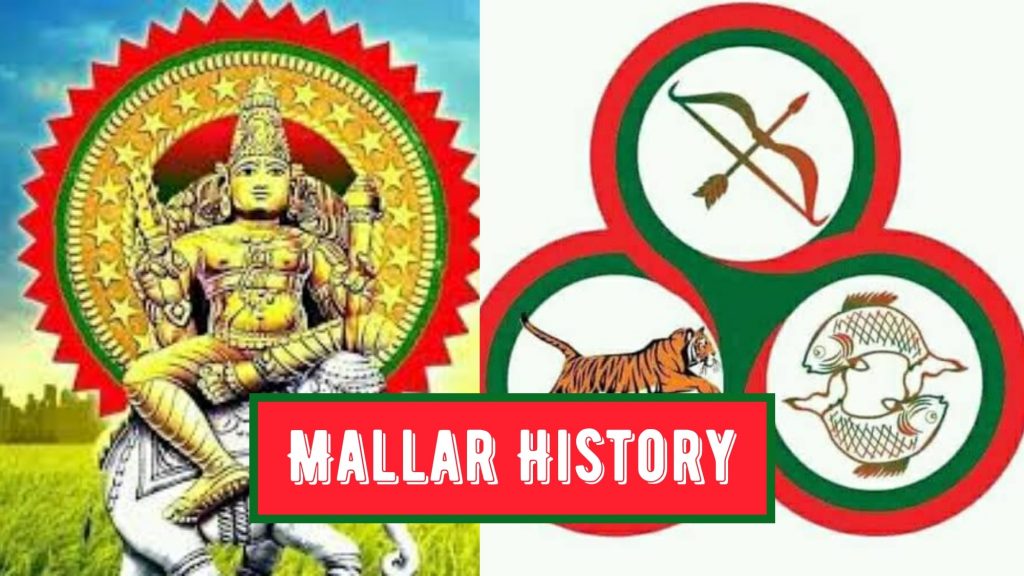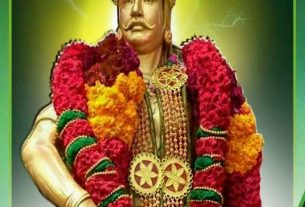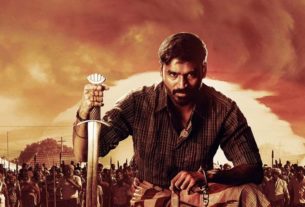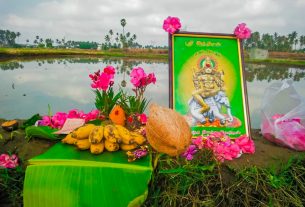The origin of the Mallar (Pallar, Deventira kula vellalar) is a disputed topic a number of historians support the argument that the Deventira kula vellalar (or) Pallar are the same community as that formerly called Mallar in the region.
Mallar History
In ancient times (3000 – 1000 BC Indus Velley Civilization) Mallar lived and ruled through out India as well as other parts of Pakistan, Bangladesh, Thailand, Laos, Afganistan, Srilanka, Iran, Chera, Chola, Pandian Kings. Malla Kings came from some other place namely legend and hearsay says from the drowned continent lemuria and they were settled in South India and contributed more to the development agriculture, brought different spices of plants like paddy, banana, turmeric beatle nuts, dugwells, created agriculture lands and formed the villages as well as cities.
Mallar (Pallar) is historically one of the oldest cultured community in India. They are the root cause of ancient civilization as well as the basis for Buddism, Saivaism, Vishnavism. Lord Buddha liked the malla kingdom, liked and spent his last years in the mallar kingdom and died there. Last rites to Buddha were done by the Mallar. So Mallar king who left the world and joined eternity was represented by the kingdom (formless infinite and eternal) who reached Lord Siva the temple built on the cremation of RajaRaja Chola was found recently in darasuram near kumbakonam in Tanjavur.
Mallar Rule
Pallava Mallar Rule in Madura Cera, Chola, Pandya the late twelth and thirteen centuries. RajaRaja I the emergence of assemblies called periya Nadu from the begining 12th century. The Nadu the periya Nattar or Mallar of the whole country assembled together Periya nadu acting over an enlarge locality and at the same time arugmenting power in the hands.
Hoysala Mallar as ther rising into Power and desired to subvert many of the surrounding monarchies.
In A.D 1023 by an inter marriage between the two dynasties the chola sovereign acquired possession of the whole of the Eastern Chalykyan dominions. This was followed apparently at begining of the region of his Successor, Rajendra kulottinga Chola (1064 -1113) by the complete subversion of the pallavas by the Chola and annexation to the latter kingdom of their possessions Rajendra also conquered the Pandiyans and established a short dynasty of Chola – Pandiyan kings at Madura
A little later the Hoysala Ballalas entirely over threw the Kongu king and seized their territories so that whole of the south of India passed at that time through a period of great political disturbance which resulted in the Cholas obtaining almost unikersal sovereignty for a short period checked however by the power of the Hoysala Ballalas above the ghats in Maisur.
We now find ourselves in the thirteenth Century the three great Souther Power being the cholas and Pandiyans both seemingly losing strength and the Hoysala Ballalas rapidly growing in power.
CHALUKYAS WESTERN
| Adityavarm | Vijayabhattaraka | Vikramaditya I | Ambera (daughter) |
|
| Vikramaditya I about S.S.592 (A.D.670 to) S.S.602 – 603 (A.D 680 – 81) According to the Kongudesa Rajakkal Sankaracharya lived during this reign a statement nearly come. |
|
| Vinayaditya – Yuddhamalla I V.Satya Sraya S.S. 602 – 603(680 – 681A.D) to S.S.618(A.D 696) |
|
| V.Jayadity S.S.618 (69 to AD) to S.S.655 (AD – 733) |
|
| Vikramaditya II married Lakamahadevi S.S.655 to 669 (A.D 733 to 747) | Bhima I |
| Kirttivarma II | Kirttivarma III |
______________________________________________________________|_ _
|
| Taila I |
|
| Vikramaditya III |
|
| Bhima II |
|
| Ayyana |
|
| Vikramaditya IV Vijitaditya Satya sraya married Bontadevi (S.S 895 – 919) 973 – 997 A.D Restorer of the dyanasty (Bunell) |
|
| Taila II Taila bhupa – Vikramaditya (or) A hava malla I |
|
| Satyasraya II married Ambikadevi S.S.919 and 930 – 997 and 1008 A.D | Dasavarma married Bhagyavati Devi |
___________________________|__
|
| Vibhuvikrama Vikramaditya V Tribhuvana malla I S.S.930 to about 940 – 1008 to 1018 A.D | Ayyana II | Akkadevi S.S.944 on 969 CA.D1022 on 1047 | Jayasimha III Jagadekamalla I about S.S.940 to about 964 about 1018 about 1042 A.D mentioned in the Tanjore inscription |
|
| Some Svara I |
| A hava malla II, Trailokya malla I about S.S. 964 to about 990 – 1042 – 1065 |
|
| Somesvara II | Vikamaditya VI (Kalivikrama) Tribhuvana malla II S.S.997 – 1048 1075 – 1126 A.D | Jayasima IV Trailokya malla I S.S.1001 – 1003 1079 – 1081 |
|
| Jeyakarna | Somesvara III or Bhulokamalla S.S.1048 – 1060 – 1126 – 1138 | Mailaladen Mamers to Jayakesi II of kadambas of Goa |
|
| Jagadeve Malla. | Taila III Trailokyamalla 1702 – 1084 – 1150 – 1162 |
The Mallar noble rule of war was noble than what is now devised in the united Nations international rules of war. Some of them includes viz, fight at a designated battlefield at deisgnated time; The Mallars also thought dying in a war fighting is martyr rather than running away as coward once initially agreed to fight. The Greek travelers were so amazed to saw the people working in farmlants unharmed and without intervention when two armies were fighting in a near by battlefield.
Mallars are mentioned in Tamil literature from the ancient Sangam literature to the recent 19th century poems, including purananuru, kamparamayanam, Thirumurukkatrupatai, Silapathigaram, Agananuru, Pathirutrupattu, Kurunthogai, Aigurunooru, Kalithogai, Natrinai and Paripaadal.
Pallu Poetry
The Mallar (Pallar) are the focus of a genre of Tamil Poetry Known as Pallu. The genire developed in the 17th and 18th centuries and depicts the pallar hero dealing with the jealousies of his two wives and the oppression of his landlord in a satirical depiction Pallarzeitgleist. The Pallu while maintaining its basic storline, developed into many forms with the Mukkudal Pallu (முக்கூடற்பள்ளு) the oldest including depiction of the struggles between shaivites and Vaishmavites.
The indigenous title of the South India Chera, Chola, Pandya kings was perumal. Mallar was the name of a perumal who built Mallur in Polanadu. Mallar is also called a rural deity which is setup on the borders or ridges of the rice field. The word Tirumal-Perumal are also derived from Mala, Malla, Both terms were originally the title given by the Mallar to their great chiefs and kings.
The king or chief of several chiefs of village was called as perumal (an elected one time ten were of 12 years) The kings or Perumal with extraordinary Valour talent and who performed well were considered as god. In ancient Malla culture the kings perumals were the protectors of the nation.
Perumal Rule
Lord Hari Hoil Prosperity. This is the order [Sasanam] of the Mallar Just and good to all people being the prosperous who are born of the four castes endure in this world. We the Mallar (Pallar) of all the quarters seated in Peace (with the lands filled with coconut, jackfruit, mango groves plantation extra) Temple of the god in Bhumidevi of the eighteen lands [bhumi] of the seventy nine countries [nadus] alias the perumal.
These Characteristics of kingship have considerable antiquity from the classical Tamil literature of seven hundred years before the great cholas three kingship were recognized during the medieval period.
The kings (Mu-vendar) Ashoka The Three kingships were called Chola, Chera, Pandya and Mallar (or) Perumal. Perumal was this the first of Cheraman or king perumal his power was begining in the late twenth century.
Name of Perumal and years
- Keya Perumal
Keya perumal and 12 years he was name (Cheraman Keralam) Perumal king of Malai Nadu Just as Chola Perumal governed Chola and Pandi (Kulasekara perumal goverened Pandya) perumal his power was limited the sixty four village constituting a powerful democracy and independence his capital Allur and Talayur. KularSekhara Perumal the great pandiyan came to the thran of kerala kaliage when the kaliage was a little advanced the Brahmans o f Malayalam from Banapuram.
Bana Perumal he became a Buddhist but after a great disputation in which the Brahmans were victorious he banished the Buddists. reconverted the Brahman religion. Never the less he was excommunicated went to Meeca.
2. Tuluban Perumal
3. Indra Perumal
4. Arya Perumal
5. Kundan Permal – 4 years
6. Kottai Perumal
7. Mata perumal – 11 Years
8. Eri perumal – 12 years
9. Kampen Perumal – 3 ½ years
10. Vijayan Perumal – 12 years
11. Vallabha Perumal he discover a lingam
12. Harisehandra Perumal Pulai Hills and lived
13. Mallar Perumal – 12 years
The Perumal who succeeded was Kulasekhara Perumal of the Pandiyan kingdom his reigion is given kshatriyas. Several village chief chose the chief known as perumal (living god) The perumal post was one time tenure of 12 years. Later with change in time the perumal became kings and their sons became the succeeding kings. when a king died without heir the next king or queen was chosen with help of the kings elephant. After prayers in the kings temple the royal kings elephant was given a garland and taken through the street. On whom ever the elephant places the garland became the next king or queen. They also elected representatives of village by placing the list of names all willing participants in a basket and prayed the village god or goddess and then picked a draw. Whose ever name came in the draw became a representative. But chola kings in the Mallar Rule brings the election process namely kudavozhai methods for selection of peoples representatives among the society. This method of polling votes still practices by the Government of India in various forms.
Indra Vella (Indira Vizha)
The great Mallar (Pallar) celebrated the festival know as Indra vella for remembering their vendan after the harvest of paddy. The Tamil kings also celebrated IndraVella every year as the thanks giving festival to the their God Devendirar. The Devendirar is agriculturist society and historically descendent’s of Lord Indra.
Rasakkal Kovil
In ancient temples like perur, Samayaburam, Tirunelveli and soon were constructed by the ancestors of Devendiar kings for remembering the same the descendants of the ancient kings are traditionally (Devndirar) brought in to the temple with festivities on elephant with while umbrella coverage playing trupts and drums. The Devendirar leader starts the temple festivals by the way of touching the temple caravan (thear) This type of first respect is still practices in various temples, which show the rich hertiage people and their ancestors are the great kings.
Buddism
The Buddism was strongly followed by the Dvendirar. The buddha priest frequently stayed among the Devendirar. In hilly area, the stone was made for the sleeping place to the buddha priest. In hilly area place was established for the education as well as health care of the people. The place was called as buddha palli. The buddha palli were destroyed by the brahmins and their loyal telugu kings. Hence one day the Devendirar conduct the protest against the telugu kings as well as brahmins. Hence the Devendirar fight against with telugu as well as telugu kings concluded for the destruction of Devendirar by the silent way to destory the Devendirar’s history.
Vijayanagar army
During the end of 14th century Vijayanagar army chiefs came to madurai and defeated the muslim rulers with the help of pandian chiefs and the vijayanagar army chief established his rule in Madurai. Gradually Vijuayanagar army and citizens moved to chola and Pandian kingdom and removed the Privileges of Tamil elite. Removal of land ownership from Tamil’s (Mallar, Devendrakulthar) and forceby transferred ownership of Land and Title to Telugu Nayaks, Telugu Brahmins and other’s who supported the Nagaka Rul. New rules were passed to stop contact with pandian and their relatives by general citizens. Rule were passed to prevent contact and intermarriage between the 18 worker communities that supported the Tamil Society and Tamil kings, Nayaks encouraged pallu literature and changed Name of the successors of Tamil kings and their relatives from Malla to pallan due to censure, low status and avoidance of contact with supporters of Tamil kings many of the Mallars migrated to kerala, ceylon and malayasia.
Hence immediate attention is required to change the name of pallan and their sub groups as mentioned earlier such as, pallar, kudumban, kaladi, pannadi, mannadi, palagan, vaigarar, devendrakulathar, mooppan kadaignyar, into Devdirar. Because all the groups are collectively referred as Devendira kula vellalar.
In 1932 the British gave the self-autonomy to Indians, 1000s of new castes sprung up claiming superiority on one over the other. Several actions were directed by other communities to keep the pallar at a low profile for fear of the other communities (new formed higher castes) loosing their claim for high caste and land ownership. In 1957 the pallar, Devendirar Community was included to the scheduled caste by Kamaraj then chief minister of Tamil Nadu, owing to the poverty of the community.
Pallar (Mallar) Population
Tamil Nadu – 2,92,6000
Andhra – 37,000
Delhi – 8,700
Karnataka – 2,800
Andaman Nicobar – 1,600
Kerala – 72,000
Maharashtra – 18,000
Pondichery – 4,400
Srilanka – 90,000
Mallah
Bihar – 1,320,000
Delhi – 70,000
Jarkant – 61,000
Chattisgar – 2,700
Uttarpradesh – 1,2,32,000
Madhyaprades – 38,000
Conclusion
Once the rulers of the mallar dynasty as well as moovender race now lost their power and refugee in their own country. The Devendirar are historically Buddhists. The Devendirar also hopes that life chakra always rotate in all direction in a short period of time the Great Mallar Race Devendirar.
Report by:





this is good, i like it, i want to know more about this kind of history.
மல்லர் மள்ளர் வேறுபாடு அறிக